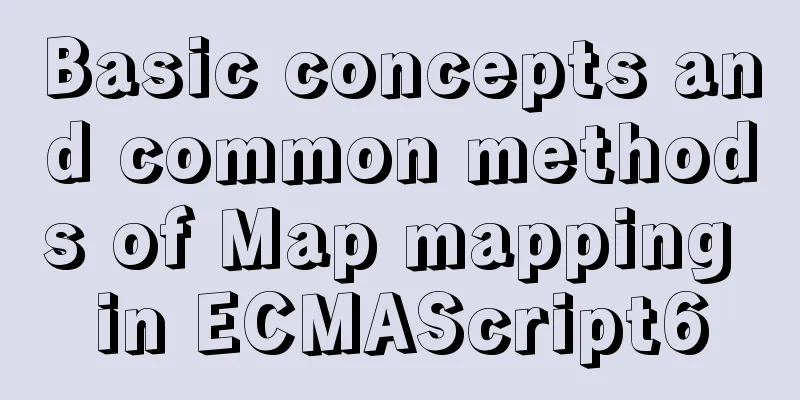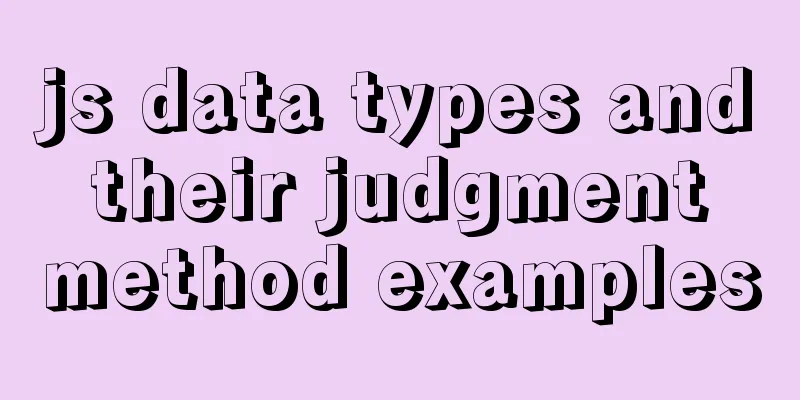Basic concepts and common methods of Map mapping in ECMAScript6

|
Map is a data structure introduced in the ECMAScript 6 specification. This is a convenient way to store lists of key-value pairs, similar to dictionaries or hash tables in other programming languages. What is a MappingJavascript objects are essentially collections of key-value pairs (Hash structures), but traditionally only strings can be used as keys, which greatly limits their use. To solve this problem, ECMAScript 6 introduced the Map data structure. It is similar to an object and is also a collection of key-value pairs, but the scope of "key" is not limited to strings, but all types of values (including objects) can be used as keys. In other words, the Object structure provides a "string-value" correspondence, while the Map structure provides a "value-value" correspondence, which is a more complete implementation of the Hash structure. Let's take a look at a simple example to understand the basic usage of Map:
//Declare a map instance const page_info = new Map()
// Add elements to the map page_info.set("seo", {
"keywords": "devpoint、Map",
"description":"The Map object is a simple key/value mapping, where the keys and values can be anything (primitive or object)"
})
page_info.set("title", "javascript es6 map")
console.log(page_info)
console.log(typeof page_info) // object
The output is:
Map {
'seo' => {
keywords: 'devpoint、Map',
description: 'The Map object is a simple key/value mapping where the keys and values can be anything (primitive or object values)'
},
'title' => 'Map mapping of javascript es6'
}
object
Judging from the output results, Map is essentially an object. Difference between Object and MapThe similarities between Object and Map are that both store and retrieve a value by key, and keys can be deleted. It can be seen that the two are very similar, the difference is that:
Map Common MethodsCommonly used Map methods include: assigning set(key, value), getting get(key), removing the specified key name and its corresponding value delete(key), checking whether has(key) exists, getting all values values(), key/value iterator entries(), traversal forEach() and clearing all key/value pairs clear(), etc. Declare and initialize
const new_map = new Map();
console.log(new_map); //Output: Map {}
Assignment setAssignment uses map.set(key,value), which can be used to add new key/value pairs or modify key/value pairs and return the entire Map object.
const page_info = new Map()
// Set the value page_info.set("seo", {
"keywords": "devpoint、Map",
"description":"The Map object is a simple key/value mapping, where the keys and values can be anything (primitive or object)"
});
console.log(page_info);
page_info.set("seo", "seo information");
console.log(page_info);
The examples above increment the value, and modify the value.
Map {
'seo' => {
keywords: 'devpoint、Map',
description: 'The Map object is a simple key/value mapping where the keys and values can be anything (primitive or object values)'
}
}
Map { 'seo' => 'seo information' }
Get key valueUse get(key) to get the key value. If the obtained key->value does not exist, it returns undefined.
const page_info = new Map();
page_info.set("title", "javascript es6 map mapping");
const title = page_info.get("title");
const seo_info = page_info.get("seo");
console.log(title); //javascript es6 map mapping console.log(seo_info); //undefined
Delete key value deletemap.delete(key) deletes the key-value pair of the specified key and returns a success or failure result. If the deletion is successful, true is returned; otherwise, false is returned.
const page_info = new Map();
page_info.set("title", "javascript es6 map mapping");
page_info.set("author", "devpoint");
console.log(page_info); // Map { 'title' => 'javascript es6 map mapping', 'author' => 'devpoint' }
const deleted_author = page_info.delete("author");
const deleted_seo = page_info.delete("seo");
console.log(deleted_author); // true
console.log(deleted_seo); // false
console.log(page_info); // Map { 'title' => 'javascript es6 map mapping' }
Determine whether the key value exists hasUse map.has(key) to check whether the specified key exists.
const page_info = new Map();
page_info.set("title", "javascript es6 map mapping");
console.log(page_info); // Map { 'title' => 'javascript es6 map mapping' }
console.log(page_info.has("title")); // true
console.log(page_info.has("seo")); // false
Get all key values()
const page_info = new Map();
page_info.set("title", "javascript es6 map mapping");
page_info.set("author", "devpoint");
console.log(page_info.values()); // [Map Iterator] { 'javascript es6 map mapping', 'devpoint' }
key/value iterator entries()Use map.entries() to return an Iterator that contains each [key, value] array in the Map object.
const page_info = new Map();
page_info.set("title", "javascript es6 map mapping");
page_info.set("author", "devpoint");
console.log(page_info.entries());
The output is:
Iterate over all key values forEach(callback)
const page_info = new Map();
page_info.set("title", "javascript es6 map mapping");
page_info.set("author", "devpoint");
page_info.forEach((value,key)=>{
console.log(key,value);
});
The output is:
Clear all key values in Map clear()Use map.clear() to clear all key-value pairs in the Map.
const page_info = new Map();
page_info.set("title", "javascript es6 map mapping");
page_info.set("author", "devpoint");
page_info.clear();
console.log(page_info); // Map {}
Conversion to and from other data structuresMap to arrayThe most convenient way to convert a Map to an array is to use the spread operator...
const page_info = new Map();
page_info.set("title", "javascript es6 map mapping");
page_info.set("author", "devpoint");
console.log([...page_info]); // [ [ 'title', 'javascript es6 map mapping' ], [ 'author', 'devpoint' ] ]
Map mapping to object
function mapToObj(map) {
const obj = Object.create(null);
map.forEach((v,k)=>{
obj[k] = v;
});
return obj;
}
const page_info = new Map();
page_info.set("title", "javascript es6 map mapping");
page_info.set("author", "devpoint");
console.log( mapToObj(page_info));
The output is:
Array to MapSimply pass the array into the Map constructor, ie new Map(array).
const page_info = [
["title","Map mapping of javascript es6"],
["author","devpoint"]
];
console.log(new Map(page_info)); // Map { 'title' => 'javascript es6 map mapping', 'author' => 'devpoint' }
Object to MapObjects are converted to Maps through Object.entries().
const page_info = {
title:"Map mapping of javascript es6",
author:"devpoint"
};
console.log(new Map(Object.entries(page_info))); // Map { 'title' => 'javascript es6 map mapping', 'author' => 'devpoint' }
Map to JSONTo convert Map to JSON, first convert the Map to an object, i.e. mapToObj above, and then use the JSON.stringify method
function mapToObj(map) {
const obj = Object.create(null);
map.forEach((v,k)=>{
obj[k] = v;
});
return obj;
}
function mapToJson(map){
return JSON.stringify(mapToObj(map));
}
const page_info = new Map();
page_info.set("title", "javascript es6 map mapping");
page_info.set("author", "devpoint");
console.log( mapToJson(page_info)); // {"title":"javascript es6 map mapping","author":"devpoint"}
SummarizeThis concludes this article about the basic concepts and common methods of Map mapping in ECMAScript6. For more relevant content about Map mapping in ECMAScript6, please search for previous articles on 123WORDPRESS.COM or continue to browse the following related articles. I hope you will support 123WORDPRESS.COM in the future! You may also be interested in:
|
<<: Detailed explanation of the solution to forget the password in MySQL 5.7
>>: linux No space left on device 500 error caused by inode fullness
Recommend
MySQL implements a solution similar to Oracle sequence
MySQL implements Oracle-like sequences Oracle gen...
Detailed explanation of the Svelte implementation principle for simple and easy JavaScript development
Table of contents Demo1 create_fragment SvelteCom...
WeChat applet realizes simple tab switching effect
This article shares the specific code for WeChat ...
Discuss the value of Web standards from four aspects with a mind map
I have roughly listed some values to stimulate ...
The principles and defects of MySQL full-text indexing
MySQL full-text index is a special index that gen...
A brief discussion on the CSS overflow mechanism
Why do you need to learn CSS overflow mechanism i...
Detailed explanation of COLLATION examples in MySQL that you may have overlooked
Preface The string types of MySQL database are CH...
Examples of importing and exporting MySQL table data
This article describes the import and export oper...
Windows CVE-2019-0708 Remote Desktop Code Execution Vulnerability Reproduction Issue
1. Vulnerability Description On May 15, 2019, Mic...
JS Difficulties Synchronous and Asynchronous and Scope and Closure and Detailed Explanation of Prototype and Prototype Chain
Table of contents JS Three Mountains Synchronous ...
HTML table markup tutorial (9): cell spacing attribute CELLSPACING
A certain distance can be set between cells in a ...
Analysis of CocosCreator's new resource management system
Table of contents 1. Resources and Construction 1...
What is TypeScript?
Table of contents 1. JavaScript issues 2. Advanta...
How to implement horizontal bar chart with percentage in echarts
Table of contents Example Code Rendering Code Ana...
Several ways to use v-bind binding with Class and Style in Vue
Adding/removing classes to elements is a very com...










